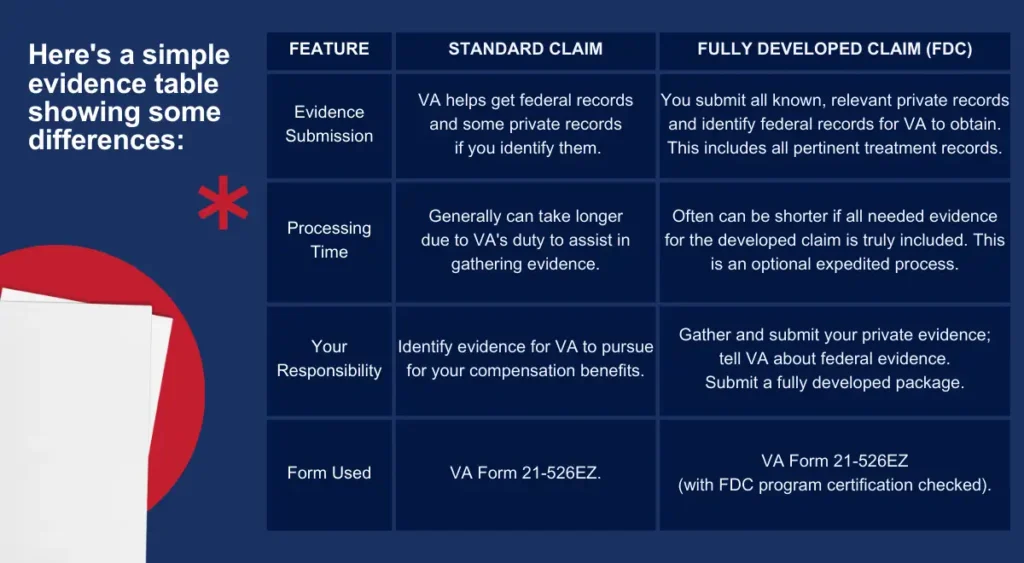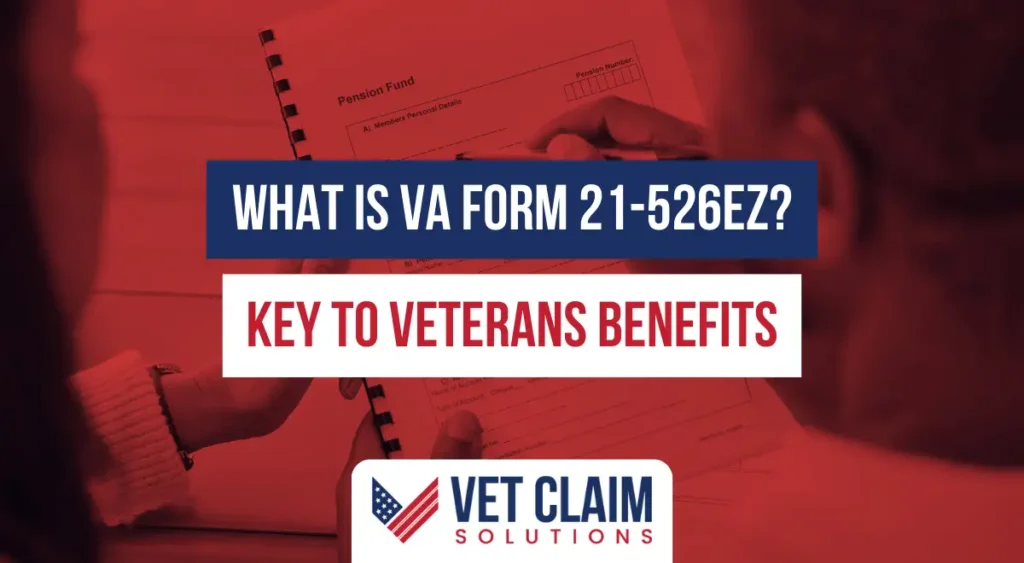Figuring out VA benefits can feel like a big hill to climb. You’ve served your country, and now you might be looking at what comes next, especially if you’re dealing with service-related health issues. You might be wondering about What Is VA Form 21-526EZ? Walks Veterans through the main form used to apply for benefits. This form is your starting point for disability compensation.
You are not alone in this journey. Many veterans have stood where you are, feeling a bit lost in the paperwork for VA compensation. This piece will give you a clear look at What Is VA Form 21-526EZ? Walks Veterans through the main form used to apply for benefits., breaking it down so it feels less like a puzzle and more like a path forward to accessing your va benefits.
So, What Exactly is VA Form 21-526EZ?
VA Form 21-526EZ is officially titled “Application for Disability Compensation and Related Compensation Benefits.” Think of it as the main key to unlock potential VA disability benefits from the Department of Veterans Affairs. It’s the standard VA form most veterans use to file an initial claim for service-connected conditions, request increased disability compensation, or reopen a previously denied claim with new evidence.
If you’re a veteran and you believe your military service, whether active duty, active duty training, or inactive duty training with the National Guard or Reserves, caused or worsened a health condition, this form is for you. You’ll use it for several reasons. These include filing your very first claim for disability or a claim for increased disability if your condition has worsened.
It’s also used if you need to ask for an increase in your current disability rating because a service-connected condition has deteriorated. You might also use it to reopen a claim that was previously denied, perhaps by submitting a supplemental claim with new and relevant evidence. This form also covers claims for conditions that are secondary to an already service-connected disability, or even claims related to special circumstances like exposure to Agent Orange. It truly is the primary document for these situations for veterans disability.

Why This Specific Form Matters for Your Claim
This isn’t just another piece of paper; it’s how you officially tell the Veterans Affairs about your disabilities and establish a service connection. Getting Form 21-526EZ filled out correctly and completely is so important for your compensation benefits. It kickstarts the entire VA review process for your disability claim and your pursuit of health care related to these conditions.
The information you give on this va form helps the VA understand your situation. They use it to gather evidence, such as treatment records from a VA medical center or private facility, schedule exams if needed, and ultimately decide on your claim. Other VA forms exist for different benefits, like applications for specially adapted housing, but for disability compensation, the 21-526EZ is where you begin your journey for benefits based on your service.
Before You Even Touch the Pen (or Keyboard): Gathering Your Ducks
Before you start filling out anything, take a deep breath. Good preparation can make a huge difference. It can make the process smoother and potentially quicker when applying for va disability benefits.
Think of it like packing for a big trip; you want to confirm you have everything you need. This way, you avoid delays and frustration down the road. Taking some time upfront will save you more time later when dealing with va forms and procedures.
Essential Information You’ll Need
Having these details handy will make completing VA Form 21-526EZ much easier. You won’t have to stop and search for things constantly. Here’s a list to get you started:
- Your full name, Social Security number (often referred to as your security number for VA purposes), and date of birth (month day year format is standard).
- Your military service number if different from your SSN.
- Details about your military service, covering all periods of active duty or relevant inactive duty. This includes your branch (e.g., Army, Navy, Air Force), dates of active service, and character of discharge. Your DD Form 214 (Certificate of Release or Discharge from Active Duty) has a lot of this vital information.
- A list of the disabilities you are claiming. For each one, try to recall when it started or worsened, and how it connects to your service. This includes physical and mental health conditions.
- Information about where you received medical treatment for these conditions. This includes VA medical centers, military hospitals, private doctors, and any federal facility. Dates of treatment are helpful to include with your completed VA form.
- Your bank account information (routing and account numbers) for direct deposit. This is how the VA will send any approved payments; it is important for receiving your va compensation without delay.
- If you are married or have dependent children, you’ll need their full names, dates of birth (month day year), and Social Security numbers. Marriage details like date and place of marriage are also needed to complete items correctly.
Keep these documents and information organized. It will be a great help as you complete item after item on the form.
How to Get Your Hands on VA Form 21-526EZ
Getting a copy of VA Form 21-526EZ is straightforward. The VA offers a few ways to access it. You can choose the one that works best for you and your situation.
The most common and often recommended method is online. You can find and submit the form through the official VA website. Many veterans use VA.gov to manage their claims electronically, which can be an expedited process compared to paper submissions.
However, filing online typically leads to faster processing and better tracking of your claim for VA benefits.
Filling Out VA Form 21-526EZ: A Section-by-Section Guide
Alright, let’s walk through the main parts of the form. Remember to read all instructions on the form itself. If you’re using a paper copy, print clearly in ink. Most importantly, be truthful and as accurate as you can be for each item you complete.

Section I: Veteran/Claimant Identification Information
This part is about you. You’ll give your full name, Social Security number, date of birth, and mailing address. Double-check everything here for accuracy; typos can cause significant delays in processing your claim for veterans disability.
Section II: Communication Information
Here, you list your phone number and email address. This is how the VA will contact you if they have questions about your application or need to submit additional information. Make sure this information stays current throughout the claim process.
Section III: Homeless Information
This section is very important if you are homeless or at risk of homelessness. Answering these questions can help the VA expedite your claim under certain special circumstances. Be honest about your housing situation; it can affect the speed of your claim for va disability.
Section IV: Claim Information (The Core of Your Application)
This is arguably the most critical section for your VA compensation. You’ll list each disability you are claiming, including any mental health conditions. For each qualifying condition, you need to briefly explain how it is connected to your military service, known as establishing a service connection.
For example, if you injured your knee during active duty training, you’d list “knee condition” and explain the incident. You’ll also note where you received treatment, like at a VA medical facility. You don’t need to write a novel, but give enough detail for the VA to understand the basis of your claim, including the month day year of incidents if possible.
If you are claiming a condition secondary to an existing service-connected disability, explain that link clearly. If you have lay evidence, such as statements from fellow service members, supporting your claim, you can reference it here or in the remarks section.
Section V: Service Information
This part covers details about your military service. You’ll provide dates of service, branch (e.g., Air Force, Army, Navy, Marines, Coast Guard), and type of discharge. This information, often found on your DD214, helps the VA verify your eligibility for benefits and is critical for processing claims related to National Guard or Reserve inactive duty training as well.
You should also include information about any periods of active duty for training or inactive duty training if your claim relates to events during those times. Some benefits, like those from the BDD program (Benefits Delivery at Discharge), are specifically for those about to leave active duty.
Section VI: Direct Deposit Information
If your claim is approved, the VA will send payments directly to your bank account. You’ll put your bank’s name, routing number, and account number here. It is the safest and fastest way to get your money, including any potential retired pay offsets or training pay adjustments related to VA compensation.
Section VII: Marital and Dependency Information
Your marital status and number of dependents can affect the amount of compensation you receive if your total disability rating reaches a certain level. If you are married, have dependent children, or dependent parents, provide their information here by completing these items carefully. Accuracy, including providing their social security number and date of birth (month day year), is key to getting the correct payment amount.
Section VIII: Fully Developed Claim (FDC) Program
This section is about the Fully Developed Claim (FDC) program, which is an optional expedited process. If you choose this path, you are certifying that you have submitted all relevant private and federal treatment records in your possession. You are also certifying that you have told the VA about any federal records, such as those from a VA medical center or other federal facility, they need to get for you.
The main benefit of the FDC program is that it can lead to a faster decision on your developed claim. We’ll talk more about this soon. This is part of the VA’s effort to streamline the standard claim process.
Section IX: Alternate Signer Information
If someone else is filling out and signing the form on your behalf (like a legal guardian or an accredited representative), their information goes here. Most veterans will sign for themselves. You would need proper authorization, like a VA Form 21-22, for someone else to sign.
Section X: Remarks
If there’s anything else you need to tell the VA that didn’t fit neatly into another section, use the Remarks section. It’s for additional details, clarifications, or to list additional evidence submitted prior. Don’t leave important facts out if they don’t seem to fit elsewhere in the completed VA form; this is your chance to provide context.
Section XI: Claimant’s Certification and Signature
This is where you sign and date the form (using month day year). Your signature certifies that the information you have given is true and correct to the best of your knowledge. An unsigned form cannot be processed and will be returned, delaying your access to potential veterans disability benefits.
The Fully Developed Claim (FDC) Program: Is It Right for You?
Let’s talk a bit more about that Fully Developed Claim program mentioned in Section VIII. It’s an option the VA offers that could speed up your claim. But, it puts more responsibility on you, the veteran, to submit a fully developed claim.
Basically, with an FDC, you’re telling the VA, “I’ve gathered all the evidence I have, and I’ve told you about any federal records I know exist that you need to get.” This includes your service medical records (SMRs), private medical records related to your conditions, relevant treatment records, and any supporting statements or lay evidence. A strong medical opinion linking your condition to service can also be very helpful here.
The big plus? FDC claims often get decided faster because the VA doesn’t have to spend as much time looking for records; it’s an optional expedited process. The downside? You must be thorough with your completed va paperwork. If you submit an FDC and forget crucial evidence, it could work against you or cause delays anyway, potentially negating the benefits of the FDC program.
VA Form 21-526EZ has a specific box to check if you’re filing under the FDC program. It’s a commitment to having done your homework on evidence gathering for your developed claim. If you believe you have all necessary documentation, this path could be advantageous.
Standard Claim Process vs. Fully Developed Claim (FDC)
So, what’s the real difference between filing a standard claim and an FDC using your VA Form 21-526EZ? In a standard claim process, the VA has a “duty to assist.” This means they will help you get relevant records, especially federal ones like your service medical records or records from VA hospitals or another VA medical facility. This sounds good, but it can also take a lot of time for the VA to track everything down.
With an FDC, you are taking the lead on gathering and submitting all private records. You also identify any federal records the VA needs to get, for example, from a previous stay at a federal facility. The VA then primarily focuses on reviewing what you’ve provided and possibly scheduling necessary exams, known as Compensation and Pension (C&P) exams. Because you’ve front-loaded the evidence with your completed VA form, they can often move to a decision more quickly on your VA disability claim.

Common Pitfalls to Sidestep When Completing Your VA Form 21-526EZ
Nobody wants their claim for VA benefits delayed because of a simple mistake. Knowing some common slip-ups can help you avoid them. Taking your time here is really important for a successful outcome regarding your health care and compensation.
One frequent issue is incomplete information. Missing Social Security numbers, dates of service (month day year format), or full addresses can slow things down. Double-check every field before you submit this critical va form.
Vague descriptions of your disabilities can also be a problem for your claim for increased disability or a new condition. Instead of just writing “back pain,” be a bit more specific like “lower back pain with radiating pain down left leg, worsened by prolonged standing, linked to parachute jump on [month day year].” Make sure you are also clear about how your service, including specific incidents during active duty training or inactive duty, is linked to the condition to establish service connection.
It might seem obvious, but forgetting to sign and date the form is a surprisingly common mistake. An unsigned form is a dead end until it’s corrected, halting progress on your veterans disability claim. Another area to watch is not including necessary supporting documents if you are trying for an FDC, or not clearly identifying records the VA needs to find if filing a standard claim. Always tell the VA about all the conditions you are claiming from your service, and if you need to submit additional evidence later, do so promptly with a clear explanation.
Also, ensure you accurately list all prior claims submitted, as this can affect how a new claim, like a supplemental claim, is processed. Failing to disclose all relevant information can complicate your path to receiving VA compensation.
Submitting Your Completed Form: The Next Steps
Once you’ve carefully filled out VA Form 21-526EZ and gathered your initial supporting documents, it’s time to submit it. You have a few options for your application for VA benefits. Filing online through VA.gov is generally the fastest and most recommended method for submitting this and other va forms.
When you submit online, you get immediate confirmation that the VA received your application for veterans disability. You can also track your claim status more easily. If you prefer to mail your application, make sure you send it to the correct evidence intake center; you can find the current address on the VA website. It is a very good idea to send it by certified mail with a return receipt requested to have proof the VA received your completed va form.
What Happens After You Submit VA Form 21-526EZ?
After you send in your form, the VA will first let you know they received it. This usually happens within a week or two if you mailed it, or instantly if you filed online. Then, your claim for VA compensation enters the VA’s review process.
A VA representative will look at your application and the evidence you submitted or identified, such as your treatment records or service history. They might find they need more information or clarification. If so, they’ll send you a letter explaining what’s needed or if you need to submit additional evidence.
Sometimes, the VA will schedule you for a Compensation and Pension (C&P) exam. This is a medical exam by a VA doctor or a VA-contracted doctor to evaluate your claimed conditions and provide a medical opinion. This exam is crucial for determining the severity of your disability and its connection to service, which affects your potential total disability rating or even a temporary total disability rating if applicable.
The entire process can take several months, sometimes longer, particularly for complex claims or those requiring extensive evidence gathering. Patience is really important during this waiting period. You can check your claim status online through your VA.gov account, which many find helpful for tracking progress as your claim moves through different stages of the standard claim process or the FDC program.

Conclusion
Understanding What Is VA Form 21-526EZ? Walks Veterans through the main form used to apply for benefits. is the very first step towards getting the disability compensation, and potentially related health care, you may have earned through your service. This VA form is detailed, yes, but it’s manageable when you take it one section at a time, making sure each item is complete. Remember, accuracy and completeness are your best friends here when pursuing your VA compensation.
Don’t let the paperwork intimidate you from seeking the VA benefits you deserve for your service-connected conditions, whether physical or related to mental health. Resources like the VA’s official website and accredited Veteran Service Officers are there to give you help with all va forms. By understanding What Is VA Form 21-526EZ? Walks Veterans through the main form used to apply for benefits. and preparing carefully, you are putting yourself in a much better position for a successful claim outcome and securing your veterans disability support.
You’ve served your country, whether on active duty, during active duty training, or even certain periods of inactive duty training. Now let the Department of Veterans Affairs serve you by providing the compensation benefits you are entitled to. Remember to use the correct month day year format for all dates and to provide your social security number accurately.


